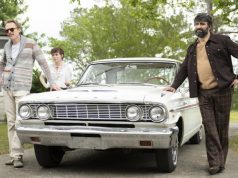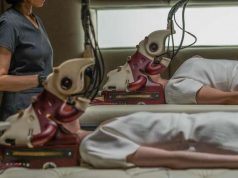“Waking the Dead” could have been a terrific movie. Instead, it’s a good movie, hampered by an intriguing storyline that winds up being misused.
The film jumps back and forth between 1973-ish and 1982-ish, piecing together bit by bit the story I’m about to summarize in a few sentences. (The jumping becomes wearying at times, especially when a scene is interrupted just as it’s getting interesting, and especially when we’re constantly being told by subtitles the year in which the current scene takes place — even when the scene’s content, clothing styles and characters make it obvious.) Idealistic young political go-getter Fielding Pierce (Billy Crudup) and liberal save-the-world free spirit Sarah Williams (Jennifer Connelly) are an unlikely couple, but in love they deeply find themselves in 1972. She becomes a liability to him in his political aspirations, though, and while their love is remarkably strong and mature, it’s marred by a lot of philosophical differences.
While trying to help some Chilean political refugees in 1974, Sarah is killed by a car bomb. Eight years later, Fielding still misses her, but has begun an empty relationship with Juliet (Molly Parker), the niece of his political mentor Isaac Green (Hal Holbrook). Isaac is helping Fielding run for congress, and everything is fine … until Fielding starts seeing Sarah everywhere he looks.
What is this? Was their love so strong it’s brought her back from the grave? Is he just hallucinating? Or was she still alive after all? Fielding is forced to figure it all out while simultaneously running for office, dealing with his non-dead girlfriend, and keeping his embarrassing brother (Paul Hipp) from becoming an embarrassing brother.
Billy Crudup’s performance is outstanding; this really is one of our best up-and-coming actors. A scene in which Fielding suffers an emotional breakdown at a restaurant is vivid and real, thanks to Crudup’s remarkably honest delivery.
Connelly has less to do, but generally succeeds in helping Fielding and Sarah’s relationship come across as legitimate. It’s a tricky thing to establish, as the film begins with her death and we learn the rest through flashbacks and flashforwards, yet somehow the romance between them emerges.
Director Keith Gordon is at times very artful in his approach, keeping the picture visually interesting without getting flashy. The tone is sadly romantic, intensified by wistful winter days and lots of falling snow.
The film’s problem is that it simply doesn’t answer enough questions. When Fielding figures out why he keeps seeing Sarah, it solves one riddle and posits a dozen more, and in the end, the film succumbs to a boiler-plate Hollywood plot-resolution formula — and an unsatisfying one, too. There are several possible explanations for Sarah’s appearances. All are far-fetched, and the movie chooses to go with the most egregious of them.
B- (; )





